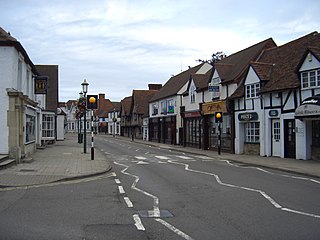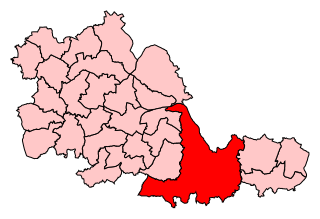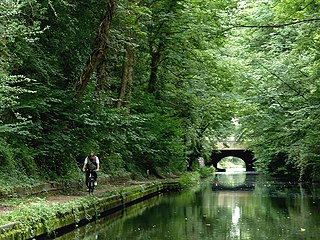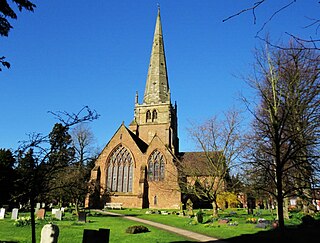
West Midlands is a metropolitan and ceremonial county in the larger West Midlands region of England. A landlocked county, it is bordered by Staffordshire to the north and west, Worcestershire to the south, and is surrounded by Warwickshire to the east. The largest settlement is the city of Birmingham.

Birmingham Airport, formerly Birmingham International Airport, is an international airport located 7 nautical miles east-southeast of Birmingham city centre, 9.5 nautical miles west-northwest of Coventry slightly north of Bickenhill village, in the Metropolitan Borough of Solihull, England.

Warwickshire is a ceremonial county in the West Midlands of England. It is bordered by Staffordshire and Leicestershire to the north, Northamptonshire to the east, Oxfordshire and Gloucestershire to the south, and Worcestershire and the West Midlands county to the west. The largest settlement is Nuneaton and the county town is Warwick.

Knowle is a large village situated 3 miles (5 km) east-southeast of the town of Solihull, West Midlands, England. Knowle lies within the Arden area of the historic county boundaries of Warwickshire, and since 1974 it has been part of the Metropolitan Borough of Solihull within the West Midlands. It lies 2.5 miles from the Warwickshire border and had a recorded population of 10,678.

North Warwickshire is a local government district with borough status in Warwickshire, England. The borough includes the two towns of Atherstone and Coleshill, and the large villages of Polesworth, Kingsbury, Hartshill and Water Orton along with smaller villages and surrounding rural areas.

Hampton in Arden is a village and civil parish located in the Forest of Arden in the Metropolitan Borough of Solihull, in the West Midlands of England. Hampton in Arden was part of Warwickshire until the 1974 boundary changes. It lies within the Meriden Gap which is an area of countryside between Solihull and Coventry.

The Metropolitan Borough of Solihull is a metropolitan borough in West Midlands county, England. It is named after its largest town, Solihull, from which Solihull Metropolitan Borough Council is based. For Eurostat purposes it is a NUTS 3 region and is one of seven boroughs or unitary districts that comprise the "West Midlands" NUTS 2 region. Much of the large residential population in the north of the borough centres on the communities of Castle Bromwich, Kingshurst, Marston Green and Smith's Wood as well as the towns of Chelmsley Wood and Fordbridge. In the south are the towns of Shirley and Solihull, as well as the large villages of Knowle, Dorridge, Meriden and Balsall Common.

Birmingham, a city and metropolitan borough in the West Midlands, England, is the second-largest city in the United Kingdom.

Meriden was a constituency represented in the House of Commons of the UK Parliament. It was named after the village of Meriden, halfway between Solihull and Coventry.

Marston Green is a village in the civil parish of Bickenhill and Marston Green, in the Metropolitan Borough of Solihull in the West Midlands. It lies within the historic county of Warwickshire. The Parish which includes the village had a population of 7,432 in the 2021 Census.
The Meriden Gap is a mostly rural area in the West Midlands between Solihull and Coventry. It is a part of the wider West Midlands Green Belt, separating Coventry from the large West Midlands conurbation, which includes Birmingham and Wolverhampton. The 'Gap' takes its name from the village central to the area, Meriden, although the largest settlement is Balsall Common. The highest point lies at 181 metres (594 ft) above sea level, slightly north of the hamlet of Eaves Green near the West Midlands-Warwickshire border.

Marston Green railway station is a station serving Chelmsley Wood and Marston Green in the Metropolitan Borough of Solihull and the Birmingham suburbs of Lea Hall and Sheldon in the West Midlands County, England. The station, and all trains serving it, are operated by West Midlands Trains.

Olton is an area/suburban village within the Metropolitan Borough of Solihull in the West Midlands, England. In the 13th century, the Lords of the Manor moved their seat and formed a new settlement, at the junction of two major roads. It was then that Ulverlei was being referred to as ‘Oulton’ to distinguish itself from nearby Solihull. Historically within the county of Warwickshire, the village has gradually become contiguous with Solihull to the southeast, though it retains the character of a large independent village.

Fordbridge is a town and civil parish in the Metropolitan Borough of Solihull, in the West Midlands, England. It is 8 miles (13 km) east of Birmingham. According to the 2001 census, the parish had a population of 8,749. Fordbridge lies within the historic county of Warwickshire.

Kingshurst is a post-war village and civil parish in the Metropolitan Borough of Solihull, in the West Midlands, England. Historically part of the county of Warwickshire in the Meriden Rural District, It lies about 7 miles (11 km) north of Solihull town centre, 10 miles (16 km) east of Birmingham and 10 miles (16km) west of Coventry, it borders North Warwickshire to the east. The village is encompassed within the electoral ward Kingshurst & Fordbridge which had a population of 7,868 in the 2011 census.
Catherine-de-Barnes is a small village within the Metropolitan Borough of Solihull in the English county of West Midlands. It is situated about 2.25 miles east of Solihull town centre, in the civil parish of Hampton in Arden, and 2 miles west of Hampton village. Population as taken in the 2011 census can be found under Bickenhill.

Solihull Metropolitan Borough Council, also known as Solihull Council, is the local authority for the Metropolitan Borough of Solihull in the West Midlands, England. It is a metropolitan borough council and provides the majority of local government services in the borough. The council has been a member of the West Midlands Combined Authority since 2016.

Solihull is a market town and the administrative centre of the Metropolitan Borough of Solihull, in the West Midlands, England. Solihull is situated on the River Blythe in the Forest of Arden area. The town had a population of 126,577 at the 2021 Census, and its wider borough had a population of 216,240. The town is located 8 miles (12 km) southeast of Birmingham and 13 miles (21 km) west of Coventry.

Elmdon is a suburban village in the civil parish of Bickenhill and Marston Green, in the Solihull district, in the county of the West Midlands, England. It is in the ancient county of Warwickshire. The population of this Solihull Ward at the 2011 census was 12,067. In 1931 the parish had a population of 225. On 1 April 1932 the parish was abolished and merged with Bickenhill and Solihull Urban.
Earlswood is a small village in Warwickshire, England in the Tanworth-in-Arden Civil parish of the Stratford-on-Avon District. However, the northernmost part of the village lies within Tidbury Green parish in the Solihull Metropolitan Borough of the West Midlands. A hamlet called Warings Green also lies in the south east of the village, with the northernmost point crossing into the parish of Cheswick Green in the borough of`Solihull. The village's postal code, B94, is in the Birmingham postcode area. It is in the ecclesiastical parish of St Patrick, Salter Street. The village is surrounded by farmland and forests and it gives its name to Earlswood Lakes as well as to Earlswood railway station, even though The Lakes railway station is located closer to the main part of the village.



















